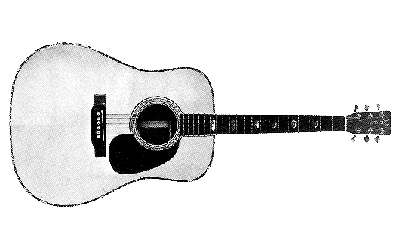

The guitar has been around in one form or another for centuries, but the principals behind how it works can be in use in musical instruments ever since the first cave man pulled the string on his bow and noticed a sound. A guitar is simply an expansion of this idea to create a series of strings tied taught, and placed over a large hollow body to resonate the sounds. There are also various styles of guitars all which have different sounds, the two most common in acoustic models being the classical, or nylon string, and the folk, or steel string. Each has their own unique sound from the materials of the strings, and the composition of the bodies, as well as the air between them.
There are six strings on a guitar, each with an open notes of E2, A2, D3, G3, B3, and E4, each with corresponding frequencies of 82 Hz, 110 Hz, 147 Hz, 196 Hz, 247 Hz, 330 Hz (Fletcher 207). These frequencies represent the root tone of each string. What makes a guitar sound the way it does is the overlay of various frequencies on each string, or the overtones present. These patterns of overtones and their strengths is what makes a guitar sound different from say, a trombone. In addition, this exact patterns of overtones is impossible to repeat, and so every instrument will sound different, and in fact every note as subtly changes from the exact location on the string where it is plucked to the force, direction, and the age of the string both off and on the guitar all have small effects on the sound.
These strings then transfer heir sound into the body of the guitar where they set up an internal resonance in the air chamber made by the body, and cause the back plate and face plate to vibrate. These vibrations cause the air to compress and rarify making the compression waves in the air that our ear interperets as sound. For a more complex discussion of these parts, see how the guitars strings, body, or the space between them works.
|
|
|||
|
Bibliography |
|||